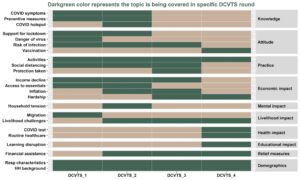
Overview: In order to understand and quantify the early impact of the Coronavirus pandemic and the pandemic induced lockdown, the National Data Innovation Centre conducted telephone surveys in both the urban and rural areas of Delhi National Capital Region (NCR). So far we have completed four rounds of Delhi NCR Coronavirus Telephone Survey (DCVTS). The widespread use of mobile phones in India provided us with the opportunity of conducting surveys remotely during the pandemic when there was a need for scientifically collected data for decision making. Moreover, the telephone mode of data collection coupled with computer-assisted technology satisfies the need of a quick turnaround in the absence of travel time and helps in measuring or informing policy responses in a timely manner.
Objectives: The objectives of the first two rounds of DCVTS (DCVTS-1; April 3-6 & DCVTS-2; April 23-26) were to estimate the levels and changes over time in people’s knowledge, attitude, perception, and practiced behavior with respect to COVID-19. The surveys also estimated the impact of the Coronavirus pandemic on people’s, income, access to essential items, social life, and their coping mechanisms (NCAER National Data Innovation Centre 2020, NCAER National Data Innovation Centre 2020, Desai and Pramanik Apr 29, 2020, Desai and Pramanik April 20, 2020, Mazumdar, Pramanik et al. May 24, 2020 ).
The third round (June 15-23) focused on the ways in which the lockdowns have affected different occupational groups (Desai and Pramanik 05 Jul 2020), levels of distress and financial hardship experienced by households, how households access welfare measures during the early phases of the pandemic (Bornali Bhandari, Santanu Pramanik et al. August 3, 2020, Choudhuri and Desai November 28, 2020), challenges in getting back to work and remaining safe after the lockdowns were lifted, and trends in social distancing and risk perceptions as the lockdowns are eased.
DCVTS-4 (December 23, 2020 – January 4, 2021), launched right before the roll out of mass vaccination, explored issues such as vaccine hesitancy (Pramanik and Desai 2021), level of disruptions in routine healthcare, the extent of learning disruptions for children in the age group of 6-14 years (Banerji, Ashraf et al. 20 Feb 2021), occupational shifts during the pandemic, vulnerability among different occupational groups, and the levels of distress and financial hardship experienced by households and whether the most vulnerable households have had access to safety nets. An overview of the topics covered across different rounds of DCVTS is given in the figure below.

Figure: An overview of the topics covered across different rounds of DCVTS